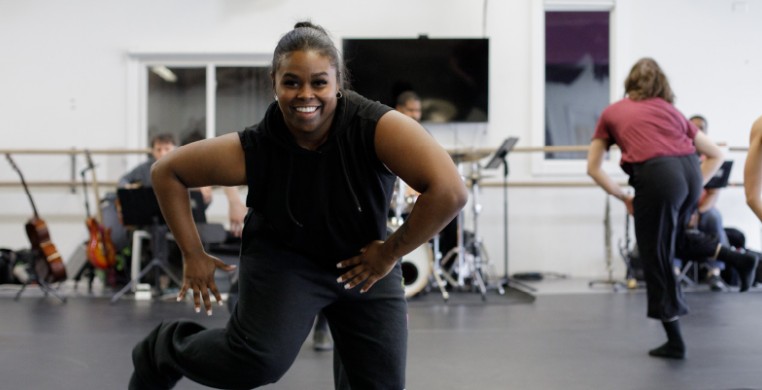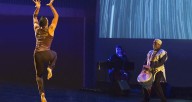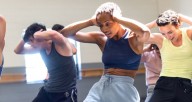For “Soul Remedy,” dancer and choreographer Monique Haley and composer and trumpeter Pharez Whitted have been taking the long-term approach to creation. In the dance world, funding can be scarce, and even when it is not there is usually a time limit attached. “Soul Remedy,” on the other hand, has been in development for nearly two years, with a near-final version planned to premiere in the Spring of 2023
This generous developmental period is due to support from the Inside/Out series, a creative incubation program presented by Cerqua Rivera Dance Theatre, which is set to present the final iteration in Spring of 2023. The Inside/Out series began in 2015 and is designed to let audiences INSIDE the creative process. Each event includes a performance of a new work-in-the-making, followed by a conversation with the artists, where the audience gets the opportunity to shape the new work through their feedback and input. Other works in the Inside/Out series are “Mood Swing,” a suite of responses to the events of 2020 and 2021 created by the dancers of Cerqua Rivera, and “Metamorphosis,” choreographed by Shannon Alvis with music by CRDT cofounder Joe Cerqua, a work inspired by non-binary/gender queer and trans Chicago dance artists.
In a pre-show introduction, Cofounder and Artistic Director of CRDT, Wilfredo Rivera, informs us that “Soul Remedy” is all about “the aesthetic of the cool,” which pertains to the famous observations made by Dr. Robert Ferris Thompson of an underlying element inherent in African art, like finding similarities in the dancing of the ancient Kongo to that of James Brown in the 1950s, or break dancing in the 1980s. In particular, West African art just looks and sounds “cool,” and “Soul Remedy” is a celebration of how this cool aesthetic has permeated every type of art and culture the world over, anywhere that African people have been, which is everywhere. Monique Haley also gave a short introduction, informing the audience of the work’s ties to African-ness and her own personal connection — Haley tells us, fighting back tears, that her lineage is traceable to the Mende people of Sierra Leone.
The music for “Soul Remedy” by Pharez Whitted is a mash up of fast, bebop jazz, swing, late 1980s and early 1990s R&B — I even heard a couple familiar riffs in the bass and drums that may have been borrowed from late ‘90s, early 2000s hip hop and dance music (though I make no accusations!). The CRDT Music Ensemble, featuring vocalist Margaret Murphy-Webb, was tight and together, despite an announcement after the show that some of them learned the music last minute, a testament to their professionalism.
To begin, Haley instructs the dancers to sit cross legged on the floor in pairs and facing one another. They maintain unbroken eye contact with each other and begin to cooperatively sway back and forth or touch each other delicately on the arm and wrist. All the while, Haley speaks words of existential guidance, and the dancers sway faster and faster, until they rise and take off running in a wide circle. They launch into improvised solos, started by company member Esther Farley, who leaps into the middle of the circle, kicking, spinning and pumping her arms explosively into the air — and that’s just the warm up!
Although you could lump certain parts of “Soul Remedy” into sections, the work generally flows from one texture to the next. In the beginning, the quality of the dancing is both Jazz and African, mixed, but distinctly separate. The dancers sit deep into their hips, their elbows held up and arms dangling down at a right angle. They then relax into some recognizable jazz dance moves, like a back-leaning, high-kneed cakewalk and a side-to side knee wagging, limp-wristed stroll. Most of the time, however, the company of dancers reflects a happy-go-lucky gaggle of lindy hoppers, crouched low and bouncing around the floor and lifting each other into the air. This Jazz/African hybrid style is a beautiful juxtaposition that disappears midway through the performance, and the dancing eases into a larger, more shape-oriented style, with dancers performing half-note extensions over a double time beat.
Nestled in between the energetic group numbers are two outstanding solos. Kennedy Phelps drifts on rays of light, gracefully bounding across the stage, propelled by Whitted’s composition, a smooth and syncopated ballad in the style of Grover Washington Jr. (with a killer saxophone solo by Dan Hessler) Several times, Phelps poses with a wide smile that shines like a spotlight and seems to make the room brighter. Vocalist Margaret Murphy-Webb steps off the bandstand and onto the stage. The interaction between singer and dancer tells ten stories at once — They could have a mother-daughter relationship, or a subject performing before a loving matriarch, or a subject appearing before a maternal god, or ancestor… there are so many ways one could interpret this piece, all of them relatable and poignant.
The second half of the program is dominated by Catera Burgess, who embodies the popular zeitgeist, and is worshipped and revered by the other dancers. Burgess, wearing a bright orange shirt while the others all wear black, fends off, politely at first, a horde of admirers. They whip her around by the arms and hoist her up into the air, and Burgess floats like a celestial Sleeping Venus. The action reaches a fever pitch, and the fans attack their idol, ripping off the orange shirt and stealing it away, leaving Burgess vulnerable. Such is the price of fame.
It's hard not to admire the process that went into creating, and is still creating, “Soul Remedy”. The opening exercise exposed the dancers to being vulnerable in front of a room full of strangers, and I overheard one audience member say after the show that it made them very uncomfortable to imagine themselves in the dancers’ position. There were blemishes (dancers on the wrong foot, heads looking at feet, stuff like that) but it’s all good. Making the audience one with the process is like watching a sculptor chipping away at a masterpiece, or watching a child grow and develop. It creates a deeper sense of commitment and intimacy for the work, and an investment that makes me yearn to see the completed work next year.



